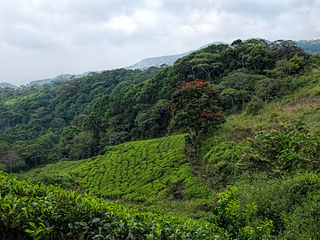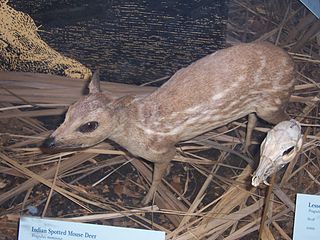
Sri Lanka, historically known as Ceylon and officially the Democratic Socialist Republic of Sri Lanka, is an island country in South Asia. It lies in the Indian Ocean, southwest of the Bay of Bengal, separated from the Indian peninsula by the Gulf of Mannar and the Palk Strait. It shares a maritime border with the Maldives in the southwest and India in the northwest.

Horton Plains National Park is a national park in the central highlands of Sri Lanka that was designated in 1988. It is located at an elevation of 2,100–2,300 m (6,900–7,500 ft) and encompasses montane grassland and cloud forest. It is rich in biodiversity and many species found here are endemic to the region. It is also a popular tourist destination and is situated 8 kilometres (5.0 mi) from Ohiya, 6 kilometres (3.7 mi) from the world-famous Ohiya Gap/Dondra Watch and 32 kilometres (20 mi) from Nuwara Eliya.

The Sri Lanka blue magpie or Ceylon magpie is a brightly coloured member of the family Corvidae, found exclusively in Sri Lanka. This species is adapted to hunting in the dense canopy, where it is highly active and nimble. Its flight is rather weak, though, and is rarely used to cover great distances. In spite of the Sri Lanka blue magpie's ability to adapt to the presence of humans, it is classified as vulnerable to extinction due to the fragmentation and destruction of its habitat of dense primary forest in the wet zone of southern Sri Lanka.

Sinharaja Forest Reserve is a forest reserve and a biodiversity hotspot in Sri Lanka. It is of international significance and has been designated a Biosphere Reserve and World Heritage Site by UNESCO.

The Sri Lankan junglefowl, also known as the Ceylon junglefowl or Lafayette's junglefowl, is a member of the Galliformes bird order which is endemic to Sri Lanka, where it is the national bird. It is closely related to the red junglefowl, the wild junglefowl from which the chicken was domesticated. However, it is even more closely related to the grey junglefowl. Sri Lankan junglefowl and red junglefowl diverged about 2.8 million years ago, whereas time of divergence between the Sri Lankan junglefowl and grey junglefowl was 1.8 million years ago.

Tourism in Sri Lanka faces many challenges, including the ongoing economic and political crisis. In 2018, tourist arrivals peaked at 2.5 million, who spent a total of US$5.6 billion in the country. However, the COVID-19 pandemic caused tourist numbers to decrease by 92% in 2020. As of 2022, tourist numbers have not rebounded from the pre-crisis high. The government is attempting to attract foreign investment in the country's tourism industry, which began in earnest after the end of the Sri Lankan Civil War in 2009.

The environment of Sri Lanka exhibits a remarkable biodiversity.

The golden palm civet is a viverrid endemic to Sri Lanka. It is listed as Vulnerable on the IUCN Red List. Its distribution is severely fragmented, and the extent and quality of its habitat in Sri Lanka's hill regions are declining.
Mus mayori is a species of rodent in the genus Mus, the mice. Its common names include Mayor's mouse, highland rat, and spiny mouse. It is endemic to Sri Lanka.

The Sri Lankan long-tailed shrew is a species of mammal in the family Soricidae. It is endemic to Sri Lanka. It is threatened by habitat loss.

Crocidura hikmiya is a species of shrew described from the rainforests of Sri Lanka, based on both morphological and molecular data. Its closest sister species is the Sri Lankan long-tailed shrew, another Sri Lankan crocidurine shrew restricted to the high-elevation habitats of the Central Highlands. C. hikmiya has a shorter tail than the Sri Lankan long-tailed shrew. Most of the other characteristics that distinguish the two species are osteological natured .
The wildlife of Sri Lanka includes its flora and fauna and their natural habitats. Sri Lanka has one of the highest rates of biological endemism.

Moschiola meminna is a species of even-toed ungulate in the chevrotain family (Tragulidae). Particularly in the old literature, M. meminna often refers to the spotted chevrotains as a whole. Today, the name is increasingly restricted to the Sri Lankan spotted chevrotain or white-spotted chevrotain, with the Indian spotted chevrotain M. indica and/or the yellow-striped chevrotain M. kathygre treated as distinct species.
Protected areas of Sri Lanka are administrated by Department of Forest Conservation and Department of Wildlife Conservation of Sri Lanka.There are 501 protected areas in Sri Lanka. The protected areas that fall under supervision of the Department of Forest Conservation include forests defined in National Heritage Wilderness Area Act in 1988, forest reservations, and forests managed for sustainability. Sinharaja Forest Reserve is an example for a National Heritage forest. There are 32 forests categorized as conservation forests including Knuckles Mountain Range. Strict nature reserves, national parks, nature reserves, forest corridors, and sanctuaries recognized under the Flora and Fauna Protection Ordinance are managed by Department of Wildlife Conservation. Total of all protected areas is 1,767,000 ha. Protected areas in Sri Lanka account for 26.5 percent of the total area. This is a higher percentage of protected areas than in all of Asia and much of the World.

Deforestation is one of the most serious environmental issues in Sri Lanka. Sri Lanka's current forest cover as of 2017 was 29.7%. In the 1920s, the island had a 49 percent forest cover but by 2005 this had fallen by approximately 26 percent. Between 1990 and 2000, Sri Lanka lost an average of 26,800 ha of forests per year. This amounts to an average annual deforestation rate of 1.14%. Between 2000 and 2005 the rate accelerated to 1.43% per annum. However, with a long history of policy and laws towards environmental protection, deforestation rates of primary cover have decreased 35% since the end of the 1990s thanks to a strong history of conservation measures. The problem of deforestation in Sri Lanka is not as significant in the southern mountainous regions as it is in northern and lowland southern Sri Lanka, largely due to the nature of environmental protection.

The Sri Lanka lowland rain forests represents Sri Lanka's Tropical rainforests below 1,000 m (3,281 ft) in elevation in the southwestern part of the island. The year-around warm, wet climate together with thousands years of isolation from mainland India have resulted in the evolution of numerous plants and animal species that can only be found in rain forests in Sri Lanka. The thick forest canopy is made up of over 150 species of trees, some of the emergent layer reaching as high as 45 m (148 ft). The lowland rain forests accounts for 2.14 percent of Sri Lanka's land area. This ecoregion is the home of the jungle shrew, a small endemic mammal of Sri Lanka. Sri Lanka has the highest density of amphibian species worldwide. Many of these, including 250 species of tree frogs, live in these rain forests.

Podochilus australiensis, commonly known as the native stream orchid, is a species of epiphytic or lithophytic orchid. It has a fern-like appearance with many thin, twisted, glossy green leaves and clusters of up to six dull white or greenish flowers with a green labellum. It grows tropical North Queensland.
Sri Lanka exhibits a remarkable biological diversity and is considered to be the richest country in Asia in terms of species concentration.













